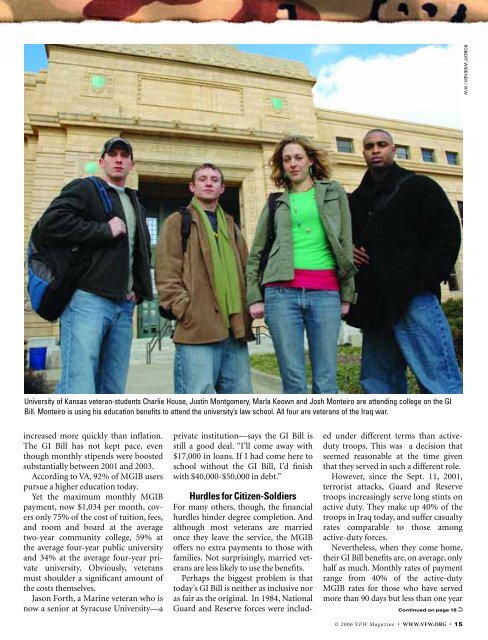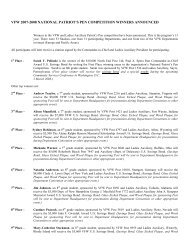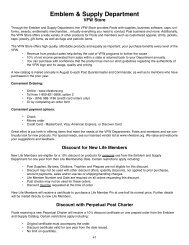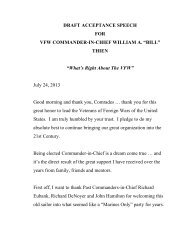2006 VFW Magazine - Veterans of Foreign Wars
2006 VFW Magazine - Veterans of Foreign Wars
2006 VFW Magazine - Veterans of Foreign Wars
Create successful ePaper yourself
Turn your PDF publications into a flip-book with our unique Google optimized e-Paper software.
ROBERT WIDENER / <strong>VFW</strong><br />
University <strong>of</strong> Kansas veteran-students Charlie House, Justin Montgomery, Marla Keown and Josh Monteiro are attending college on the GI<br />
Bill. Monteiro is using his education benefits to attend the university’s law school. All four are veterans <strong>of</strong> the Iraq war.<br />
increased more quickly than inflation.<br />
The GI Bill has not kept pace, even<br />
though monthly stipends were boosted<br />
substantially between 2001 and 2003.<br />
According to VA, 92% <strong>of</strong> MGIB users<br />
pursue a higher education today.<br />
Yet the maximum monthly MGIB<br />
payment, now $1,034 per month, covers<br />
only 75% <strong>of</strong> the cost <strong>of</strong> tuition, fees,<br />
and room and board at the average<br />
two-year community college, 59% at<br />
the average four-year public university<br />
and 34% at the average four-year private<br />
university. Obviously, veterans<br />
must shoulder a significant amount <strong>of</strong><br />
the costs themselves.<br />
Jason Forth, a Marine veteran who is<br />
now a senior at Syracuse University—a<br />
private institution—says the GI Bill is<br />
still a good deal. “I’ll come away with<br />
$17,000 in loans. If I had come here to<br />
school without the GI Bill, I’d finish<br />
with $40,000-$50,000 in debt.”<br />
Hurdles for Citizen-Soldiers<br />
For many others, though, the financial<br />
hurdles hinder degree completion. And<br />
although most veterans are married<br />
once they leave the service, the MGIB<br />
<strong>of</strong>fers no extra payments to those with<br />
families. Not surprisingly, married veterans<br />
are less likely to use the benefits.<br />
Perhaps the biggest problem is that<br />
today’s GI Bill is neither as inclusive nor<br />
as fair as the original. In 1984, National<br />
Guard and Reserve forces were included<br />
under different terms than activeduty<br />
troops. This was a decision that<br />
seemed reasonable at the time given<br />
that they served in such a different role.<br />
However, since the Sept. 11, 2001,<br />
terrorist attacks, Guard and Reserve<br />
troops increasingly serve long stints on<br />
active duty. They make up 40% <strong>of</strong> the<br />
troops in Iraq today, and suffer casualty<br />
rates comparable to those among<br />
active-duty forces.<br />
Nevertheless, when they come home,<br />
their GI Bill benefits are, on average, only<br />
half as much. Monthly rates <strong>of</strong> payment<br />
range from 40% <strong>of</strong> the active-duty<br />
MGIB rates for those who have served<br />
more than 90 days but less than one year<br />
Continued on page 18 ➲<br />
© <strong>2006</strong> <strong>VFW</strong> <strong>Magazine</strong> • WWW.<strong>VFW</strong>.ORG • 15
















